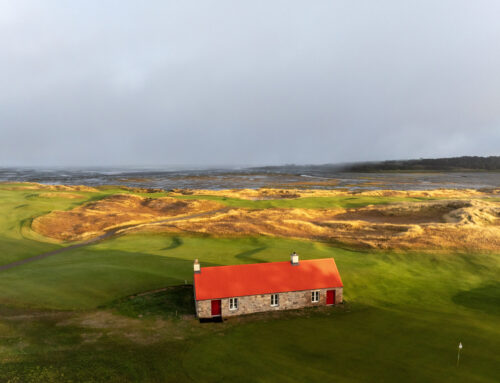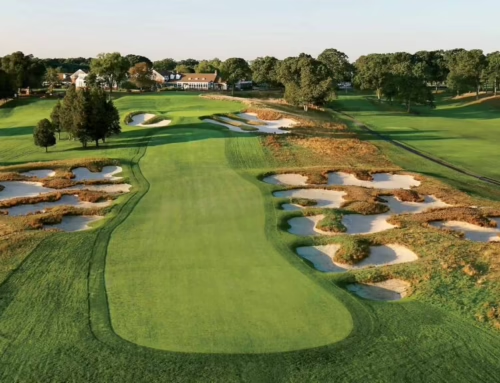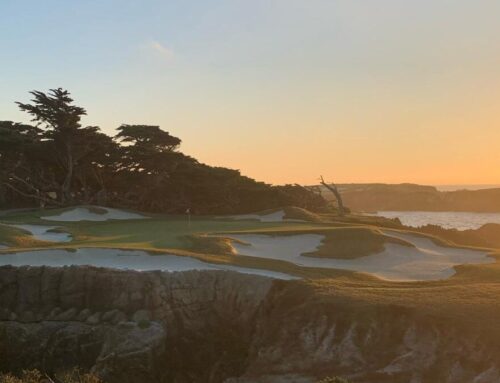On Thursday, the world’s best will descend on Walton-on-the-Hill for the 2023 instalment of The AIG Women’s Open where Ashleigh Buhai will be defending her crown, having won at Muirfield last year in a nail biting – albeit slow paced – playoff. The event is also throwing in some extra special touches: an Ellie Goulding concert on Saturday night and a reimagined fan experience.
In anticipation I took to the comprehensive book about the clubs’ founding architect – Herbert Fowler, ‘Matter of Course’ by Derek Markham ably supported by revered golf historian Philip Truett – to try and learn a bit more about Walton Heath, and Fowler as a person. Here are 5 things I did not know:
1. Cosmo Bonsor was the man behind the development.
A member of British high society, millionaire by virtue of the brewing industry, a member of parliament, director of the Bank of England and wealthy landowner, Bonsor also happened to be married to the sister of Herbert Fowler’s wife.
Chairman of the South Eastern Railway Company who had recently brought the lines out to nearby Tadworth and Kingswood where he lived, Bonsor purchased a huge swathe of land, including 500 acres of sprawling heathland which would be ringfenced for use as a golf course.
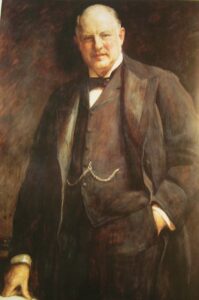
Cosmo Bonsor
Despite quite literally being born into the pound seats, Fowler was a little down on his luck at the turn of the century. The economic outlook was not as rosy as it might have been 20 years ago, and with his fortunes waning (owing partly to a standard of living which must have taken its toll financially), the bon-viveur Fowler was left with no option but to leave Taunton, resign from his bank which he was a partner in and leave his beloved Claremont country pile which he had called home since moving to the area.
As well as being his brother in law, Cosmo Bonsor was also a creditor of Fowlers – no doubt helping him financially through this period of readjustment – so when the opportunity came up to build a golf course on the expanse of healthland on the south of London, he would have been in no doubt about hiring Fowler to design and build the course. By now a well respected figure in the game, a strong player in his own right and outspoken on the topic of golf course design, Fowler would almost certainly be able to repay his debt to Cosmo in one form or another.
To do so, he set off to Walton Heath on horseback in 1903, inspecting the 3 foot high heather and established what he felt would serve as two good short holes, and earmarked land for an outward nine and a returning nine to the clubhouse.
Bracken and heather was cleared and G.A. Franks (famous for constructing many of Britain’s Golden Age courses as the partnership ‘Frank’s Harris’ with Colt most notably) were tasked with bringing the course to life. Walton Heath was being developed at the very early stages of accepted golf course architecture. Sunningdale had only opened for play in 1901, and Stuart Paton had only recently ushered in a new age of strategic golf course design with the totemic placement of the two bunkers in the centre of the fairway on Woking’s fourth hole. Until then very little was discussed about golf design beyond the previously accepted school of penal architecture and cross hazards to capture poor shots.
As such, Herbert Fowler was blazing a trail in golf course design. More about Fowler’s principles in an upcoming dispatch.
2. It was the first 36 hole club in England.
Surrey has become known for these sprawling heathland 36-hole playgrounds, with two courses offering unrivalled fun and excitement, while 2 and 4 ball play is balanced across two courses on some form of regular rota, the likes of Sunningdale and The Berkshire boasting similar facilities.
Very soon after the opening of The Old Course, the Club had risen to 600 members, 100 of them women. Clearly demand for the sport was rampant and as such a further nine holes was suggested and built in 1907, and in 1913 the remainder of the New Course was finished with Walton Heath the only English club at the time able to boast two championship courses.
Whilst nowadays this means play across either the New or the Old alternates for 4 ball play, and the other for 2 or 3 ball play, it’s interesting to note that this is not how Fowler would have had things.
An outspoken and at times radical character, he was not a supporter of four ball golf and throughout his tenure on the R&A Championship Committee was a staunch supporter of foursomes golf, especially within the context of The Walker Cup.
He was once quoted:
‘’I must say a word against the four-ball match. On very crowded greens it may be a means of allowing a few extra players to get a game, but otherwise I think that its influence is altogether bad, and that it will do great harm to individuals so far as their game is concerned. I once heard the suggestion to play an important match on these lines, but I trust that such a ridiculous thing will never take place’’
The first two days of the AIG will played in 3 balls.
3. The club was owned by Rupert Murdoch for a brief time.
Despite the development of the M25, a changing economic climate and two world wars, Walton Heath has always been regarded as one of the great English clubs. Interestingly, the ownership of the club was passed to The News of The World in the mid-1950’s which was then passed to the Australian media-mogul, Rupert Murdoch, in 1969 when he acquired the newspaper. The members purchased the club in 1971 which was also the first time it came into the hands of its members rather than a proprietary owner.
In fact, The News of the World Matchplay Tournament was (with the exception of The Open Championship), the most prestigious event of the professional calendar first played in 1903. It was first played at Walton Heath in 1905 when it was won by the local club professional and 5-time Open Champion James Braid (the club hosted the event 21 times all told). Lord Riddell, the Club’s proprietor was the Managing Director at The News of the World, and was no doubt instrumental in the founding of the event.
This iconic championship changed the name of its title sponsor in the same year as Murdoch’s acquisition who clearly had little interest in the sponsorship of professional golf tournaments nor did he see a need to own a golf course. Some iconic sponsors followed in the next ten years as the event scrambled to retain the same prestige with which it had always been known: Long John Scotch Whiskey, Benson & Hedges and Sun Alliance.
It seems that the unpredictability of matchplay tournaments back then were just as problematic for their title sponsors as the final could not be guaranteed upon to provide a spectacle. The event folded in 1979 and what we know now as the BMW was the event which had begun to eclipse what was regarded in the first half of the 20th century as a very significant event.
4. The famous depressions in the earth at Walton Heath are called ‘solution hollows’
In 1903, the ability to move earth was very limited, and Fowler had spent much of his time learning to play the game at Royal North Devon, known for its natural aesthetic.
When speaking of Herbert Fowler, Tom Doak was quoted as saying;
‘’My own style of design has been labeled as ‘’minimalism’’, but it is really just a distillation of all the fine courses I have seen that were built before the age of bulldozers when ‘less is more’….
…Of course it makes sense that a golfer who learned the game at Westward Ho! Would design courses that are as natural as possible.’’
Given his exposure to windswept linksland courses in the late 19th century, Fowler would have no reason to look to create more in the land as an architect than he was required to.
Fowler needed to work with what the land provided. The course to this day is famous for its natural and wild setting, a far cry from the picture-perfect heathlands of The Berkshire or Sunningdale, and this aesthetic makes Walton Heath somewhat unique, often referred to as ‘an inland links’.
In addition to the carpets of heather that line the fairway and engulf the bunker faces, Walton Heath has a number of dells and hollows which act as a coffin for an errant shot. These rare features were used throughout Fowler’s design to create strategic value. He placed immense importance on the placement and construction of hazards as an architect and felt this is what separated the good courses from the bad.

Whilst it was rumoured that these harked back to Roman times – used for shelter and accommodation – the depressions in the land at Walton Heath are known as ‘solution hollows’, and are naturally occurring geological faults.
Whether the players this week see them with the same positive mindset as their name dictates we can but wonder…

Standing above a ‘solution hollow’.
5. Royal and political names a plenty
George Riddell was the Club’s owner in its early years after Cosmo Bonsor sold the club following its successful launch. Later known as Sir George (and even later Lord Riddell of Walton Heath) he presided over a Club which boasted 6 cabinet ministers in 1913. The story goes that during World War II Sir Winston Churchill & David Lloyd George would use Walton Heath as a sanctuary to discuss wartime tactics.
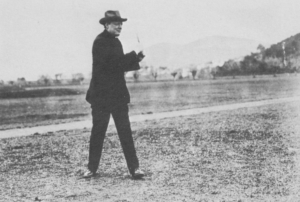
Winston Churchill was a member at Walton Heath.
Whether that’s true or not hardly matters, Walton Heath was the choice hangout for the parliamentary and business elite of London for a number of years. The Prince of Wales became the first Club Captain in 1935 and succeeded to the throne in 1936 making Walton Heath unique as the only English club to boast a monarch as a member.

Edward VIII at Walton Heath.
Walton Heath is one of the most storied clubs around Britain, an early pioneer in the evolution of the game and innovated in a quickly evolving world of golf, especially supporting the development of the women’s game:
- In 1910 the Club hosted a 72-hole ‘Men v Women’ match. An exhibition played between Harold Hilton & Cecil Leitch across Walton Heath & Sunningdale. Leitch won the encounter 2&1. (for more on Cecil Leitch, please watch our film from Silloth on Solway).
- In 1914 the Club hosted the English Ladies Championship, the first of 2 at Walton Heath.
- In 1968, Walton Heath hosted the British Ladies Championship, the first of 3 at the Club.
- In 1982 Katrina Douglas won the British Ladies Amateur Championship at Walton Heath, and the next year Walton Heath member Jill Thornhill won the event. The event was held at Walton Heath again in 2000 when Rebecca Hudson was victorious.
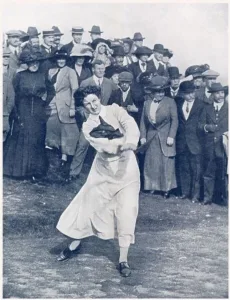
Cecil Leitch in action at Walton Heath against Harold Hilton


